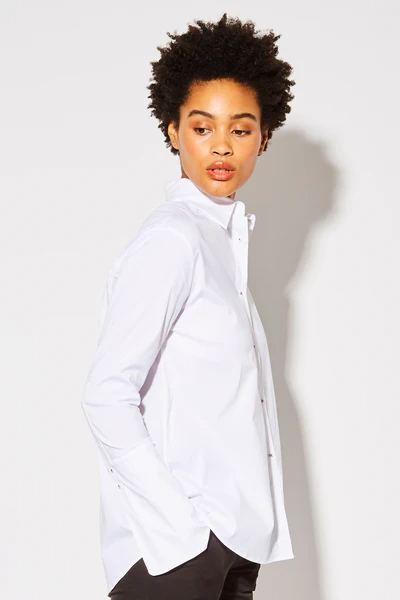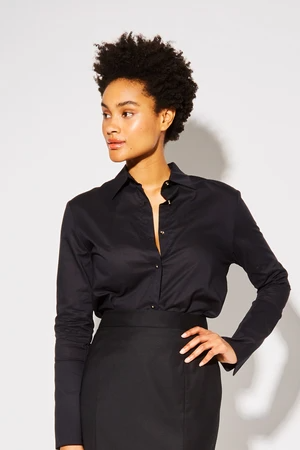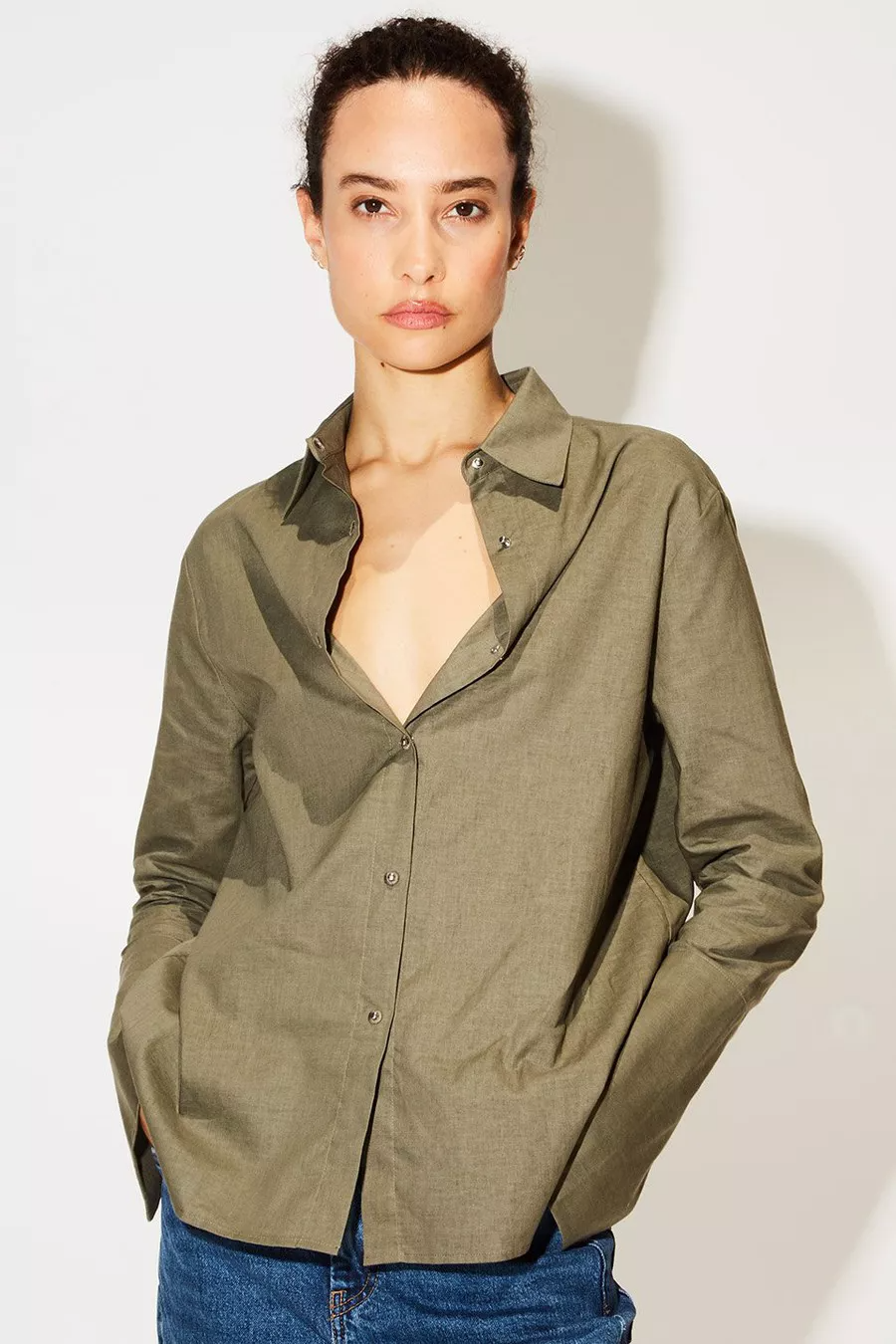Misha Nonoo Reimagined This Meghan Markle-Approved Shirt
Few white shirts have gotten as much recognition as the one Meghan Markle wore for her first public appearance with Prince Harry in 2017. Now, the designer behind the shirt, Misha Nonoo, is once again reimagining the beloved style with a tuxedo stud collaboration with jewelry designer Fry Powers.
Twelve stud packs, ranging from fuchsia to sky blue and violet, make up the collaboration which the British-Bahraini, New York-based designer refers to as “jewelry” for our current time. "In this pandemic world, where you aren’t going out and about so much, jewelry isn’t the same as it was six months ago. You’re not necessarily wearing a dangly pair of earrings. You’re thinking about jewelry maybe differently — or certainly, I am. I thought, How can I reimagine the stud on the Husband Shirt to make it really special and make it a piece of jewelry? And that was how this all came to be,” Nonoo says. “You can put the studs into a pre-existing shirt, you can swap the studs out, so just giving you more mileage out of a piece you already have.”
AdvertisementADVERTISEMENT
To this day, the Husband Shirt silhouette, an oversized button-down, remains one of the brand’s most popular items. “Based on the fact that it has been seen in such a high-profile way, people really loved it, and I think they loved the way it was styled in that appearance, and it kind of just took a life of its own,” Nonoo says. “It was the linchpin of the collection before, and I think that it really became the linchpin ever after.” Since then, Nonoo reinvented it in a variety of colors and materials, in maternity while she was pregnant with her first child, and, following the beginning of the pandemic, with a hidden collar message "Distance, not distant," a donation from which goes to frontline healthcare efforts through the World Health Organization’s COVID-19 response team. “We’re very much a values-driven business, and I think that, for all of us on the team, myself particularly, my heart went out to the people who were on the frontlines working day in, day out tirelessly, putting their own life at risk to help others,” she says. “I thought the least we can do is to offer contributions, and then offer gift cards to healthcare workers.”
Pairing up with Fry Powers, who uses recycled materials, came about naturally for the sustainable brand. "I love [founder] Allison [Fry’s] values, I love that some of the materials used are upcycled and that she’s really thinking cleverly about sustainability from a jewelry perspective the way that we do from a fashion perspective,” Nonoo says. “If we aren’t thinking about how we’re doing business — and that to me is sustainability, how we really are thinking about the mark we’re leaving on the world — then I think we’re being a bit irresponsible. In my mind, it’s very important that we take on a responsibility for the environment and the people that we’re passing this world down to.”
AdvertisementADVERTISEMENT
It’s one of the main reasons that she pivoted the brand to produce clothing on-demand when relaunching the business in 2016. “The majority of fashion brands produce inventory upfront, and there’s no way to know how much you’re actually going to sell, so they’re taking an educated guess at best,” she says. “No matter what happens, at the end of the season, there’s always going to be stock inventory that is left over, and that inventory, more often than not, ends up being burned if it’s a high-fashion brand, or it will end up in a landfill. Both of those are wasteful and damaging to the environment, and it is for that reason that I take the approach of producing every piece on-demand.” After an order is made online or in the store, the brand produces it within two weeks and ships it to the customer. In addition to this, Misha Nonoo has other sustainability initiatives in place, including recycled paper in shipments, sustainable fabrications, and working with factories with ethical practices, among other things.
Introducing the on-demand model wasn’t the only change that Nonoo made with the relaunch. That same year, she abandoned the wholesale model in favor of direct-to-consumer sales. “[Department stores] operate on gross margin agreements that are very difficult for boutique brands like myself to work with and be profitable with. In fact, I had a fairly large business, and I wasn’t profitable because the gross margins we agreed to meant that we were in a never-ending cycle of discounts and markdowns and promotional calendars,” she says. “I think it took a moment for me to say, ‘This has to stop, it has to feel more special.’ A piece that you’re adding to your wardrobe, in my mind, needed to feel more special than what it did.” This is a topic that many independent designers have spoken about recently.
AdvertisementADVERTISEMENT
In another ahead-of-its-time move, during the 2016 Spring New York Fashion Week, Nonoo showed her new collection virtually on Instagram. “[Back then,] I really wanted to think about how I could do something differently, and marketing is all about spreading your message in the right way, and I didn’t feel like the right way was to continue to do runway shows when only a few people who weren’t even my consumers — they were fashion editors or buyers at department shows — coming to my show,” she says. “I thought, Why am I spending all this time and money and effort marketing to them for them to hopefully tell the consumer? I have this tool on Instagram, why don’t I use this to my advantage and speak straight to my customer?”
Five years later, amidst the pandemic, we’re now seeing the rise of the virtual fashion show.
When talking to her about having this foresight, Nonoo says that she has only done things that felt right for her business at the time. “People would say, ‘Oh what’s next for you?' after I’ve done a few things that were innovative, and I would say, ‘Actually, I am not doing things for the sake of being innovative or being called an innovator. I am doing it because it makes sense for my business,” she says.
All to say: Don’t go asking her what the next big trend or movement in fashion will be. “I think sometimes things seem groundbreaking at the time or they don’t seem groundbreaking at the time, but it’s all of these small iterations that add up to kind of big innovations,” she says. “It’s knowing when something is wrong just as much as knowing when something is right that has led me to make the decisions that I’ve made.”
AdvertisementADVERTISEMENT









